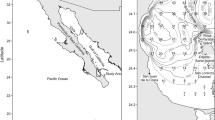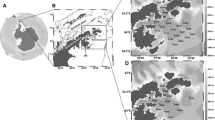Abstract
SeaWiFS ocean color measurements were used to investigate interannual, monthly, and weekly variations in chlorophylla (chla) on the Louisiana shelf and to assess relationships with river discharge, nitrate load, and hypoxia. During the study period (2000–2003), interannual changes in shelf-wide chla concentrations averaged over January–July ranged from +57% to −33% of the 4-yr average, in accord with freshwater discharge changes of +20% to −29% and nitrate load changes of +20% to −35% from the Mississippi and Atchafalaya Rivers. Chla variations were largest on the shelf between the Mississippi and Atchafalaya Deltas. Within this region, which corresponds spatially to the area of most frequent hypoxia, lowest January–July mean chla concentrations (5.5 mg m−3 over 7,000 km2) occurred during 2000, the year of lowest freshwater discharge (16,136 m3 s−1) and nitrate load (55,738 MT N d−1) onto the shelf. Highest January–July mean chla concentrations (13 mg m−3 over 7,000 km2) were measured in 2002, when freshwater discharge (27,440 m3s−1) and nitrate load (101,761 MT N d−1) were highest and second highest, respectively. Positive correlations (R2=0.4–0.5) were found between chla and both fresh water and nitrate loads with 0 to 1 month lags, with the strongest relationships just west of the Mississippi Delta. In 2001, unusually clear skies allowed the identification of distinct spring and summer chla blooms west of the Mississippi Delta 4–5 wk after peaks in river discharge. East of the delta, the chla concentrations peaked in June and July, following the seasonal reversal in the coastal current. A clear linkage was not detected between satellite-measured chla and hypoxia during the 4-yr period, based on a time series of bottom oxygen concentrations at one station within the area of most frequent hypoxia. Clear relationships are confounded by the interaction of physical processes (wind stress effects) with the seasonal cycle of nutrient-enhanced productivity and are influenced by the prior year's nitrate load and carbon accumulation at the seabed.
Similar content being viewed by others
Literature Cited
Bierman, Jr.,V. J., S. C. Hinz, D. Zhu, W. J. Wiseman, Jr.,N. N. Rabalais, andR. E. Turner. 1994. A preliminary mass balance model of primary productivity and dissolved oxygen in the Mississippi River Plume/Inner Gulf shelf region.Estuaries 17: 886–899.
Boesch, D. F. 2002. Challenges and opportunities for science in reducing nutrient over-enrichment of coastal ecosystems.Estuaries 25:886–900.
Bratkovich, A., S. P. Dinnel, andD. A. Goolsby. 1994. Variability and prediction of freshwater and nitrate fluxes for the Louisiana-Texas shelf: Mississippi and Atchafalaya River source functions.Estuaries 17:766–778.
Carder, K. L., R. G. Steward, G. R. Harvey, andP. B. Ortner. 1989. Marine humic and fulvic acids: Their effects on remote sensing of ocean chlorophyll.Limnology and Oceanography 34:68–81.
Cochrane, J. D., andF. J. Kelly. 1986. Low-frequency circulation on the Texas-Louisiana continental shelf.Journal of Geophysical Research 91:10645–10659.
Diaz, R. J., andR. Rosenberg. 1995. Marine benthic hypoxia: A review of its ecological effects and the behavioral responses of benthic macrofauna.Oceanography and Marine Biology Annual Review 33:245–303.
Dortch, Q., N. N. Rabalais, R. E. Turner, andG. T. Rowe. 1994. Respiration rates and hypoxia on the Louisiana shelf.Estuaries 17:862–872.
Eppley, R. W., E. Stewart, M. R. Abbott, andU. Heyman. 1985. Estimating ocean primary production from satellite chlorophyll. Introduction to regional differences and statistics for the southern California Bight.Journal of Plankton Research 7:57–70.
Goolsby, D. A., W. A. Battaglin, G. B. Lawrence, R. S. Artz, B. T. Aulenbach, R. P. Hooper, D. R. Keeney, andG. J. Stensland. 1999. Flux and sources of nutrients in the Mississippi-Atchafalaya River Basin: Topic 3 Report for the Integrated Assessment of Hypoxia in the Gulf of Mexico, Decision Analysis Series No. 17. NOAA Coastal Ocean Office, Silver Spring, Maryland.
Gordon, H. R., andM. Wang. 1994. Retrieval of water leaving radiance and aerosol optical thickness over the oceans with SeaWiFS: A preliminary algorithm.Applied Optics 33:443–452.
Hooker, S. B., andC. R. McClain. 2000. The calibration and validation of SeaWiFS data.Progress in Oceanography 45:427–465.
Hsu, S. A. 1988. Coastal Meteorology. Academic Press Inc., San Diego, California.
Hu, C., F. E. Muller-Karger, C. Taylor, K. Carder, C. Kelble, E. Johns, andC. Heil. 2005. Red tide detection and tracing using MODIS fluorescence data: A regional example in SW Florida coastal waters.Remote Sensing of Environment 97:311–321.
Justić, D., N. N. Rabalais, andR. E. Turner. 1996. Effects of climate change on hypoxia in coastal waters: A doubled CO2 scenario for the northern Gulf of Mexico.Limnology and Oceanography 41:992–1003.
Justić, D., N. N. Rabalais, andR. E. Turner. 1997. Impacts of climate change on net productivity of coastal waters: Implications for carbon budget and hypoxia.Climate Research 8:225–237.
Justić, D., N. N. Rabalais, R. E. Turner, andW. J. Wiseman, Jr. 1993. Seasonal coupling between river borne nutrients, net productivity, and hypoxia.Marine Pollution Bulletin 26:184–189.
Lohrenz, S. E., M. J. Dagg, andT. E. Whitledge. 1990. Enhanced primary production at the plume/oceanic interface of the Mississippi River.Continental Shelf Research 10:639–664.
Lohrenz, S. E., G. L. Fahnenstiel, D. G. Redalje, G. A. Lang, X. Chen, andM. J. Dagg. 1997. Variations in primary production of northern Gulf of Mexico continental shelf waters linked to nutrient inputs from the Mississippi River.Marine Ecology Progress Series 155:45–54.
Meade, R. H. 1996. River-sediment inputs to major deltas. p. 63–85.In J. D. Milliman and U. D. Haq (eds.), Sea Level Rise and Coastal Subsidence: Causes, Consequences and Strategies. Kluwer Academic Publishers, Dordrecht, Netherlands.
Milliman, J. D., andR. H. Meade. 1983. Worldwide delivery of river sediment to the oceanJournal of Geology 91:1–21.
Morey, S. L., P. J. Martin, J. J. O'Brien, A. A. Wallcraft, andJ. Zavalo-Hidalgo. 2003. Export pathways for river discharged fresh water in the northern Gulf of Mexico.Journal of Geophysical Research 108, 3303, doi: 10.1029/2002JC001674.
Muller-Karger, F. E., J. J. Walsh, R. H. Evans, andM. B. Meyers. 1991. On the seasonal phytoplankton concentration and sea surface temperature cycles of the Gulf of Mexico as determined by satellites.Journal of Geophysical Research 96:12645–12665.
Murray, S. P. 1972. Observations on wind, tidal and density-driven currents in the vicinity of the Mississippi River delta, p. 127–142.In D. J. P. Swift, D. B. Duane, and O. H. Pilkey (eds.), Shelf Sediment Transport. Dowden, Hutchinson and Ross, Inc, Stroudsburg, Pennsylvania.
Murray, S. P., E. Jarosz, andE. T. Weeks, III. 1998. Physical oceanographic observations of the coastal plume, p. 5–105.In S. P. Murray (ed.), An Observational Study of the Mississippi-Atchafalaya Coastal Plume, OCS Study MMS 98-0040. U.S. Minerals Management Service, New Orleans, Louisiana.
O’Reilly, J. E., S. Maritorena, B. G. Mitchell, D. Siegel, K. Carder, S. Garver, M. Kahru, andC. McClain. 1998. Ocean color chlorophyll algorithms for SeaWiFS.Journal of Geophysical Research 103:24937–24953.
Parsons, T. R., Y. Maita, andM. Lalli. 1984. A Manual of Chemical and Biological Methods for Seawater Analysis. Pergamon Press, New York.
Rabalais, N. N., D. E. Harper, Jr., andR. E. Turner. 2001a. Responses of nekton and demersal and benthic fauna to decreasing oxygen concentrations. p. 115–128.In N. N. Rabalais and R. E. Turner (eds.), Coastal Hypoxia: Consequences for Living Resources and Ecosystems. Coastal and Estuarine Studies 58, American Geophysical Union, Washington, D.C.
Rabalais, N. N., L. E. Smith, D. E. Harper, Jr., andD. Justić. 2001b. Effects of seasonal hypoxia on continental shelf benthos, p. 211–240.In N. N. Rabalais and R. E. Turner (eds.), Coastal Hypoxia: Consequences for Living Resources and Ecosystems. Coastal and Estuarine Studies 58, American Geophysical Union, Washington, D.C.
Rabalais, N. N., R. E. Turner, Q. Dortch, D. Justić, V. J. Bierman, Jr., andW. J. Wiseman, Jr. 2002b. Review. Nutrient-enhanced productivity in the northern Gulf of Mexico: Past, present and future.Hydrobiologia 475/476:39–63.
Rabalais, N. N., R. E. Turner, andD. Scavia. 2002a. Beyond science into policy: Gulf of Mexico hypoxia and the Mississippi River.BioScience 52:129–142.
Rabalais, N. N., R. E. Turner, W. J. Wiseman, Jr., andD. F. Boesch. 1991. A brief summary of hypoxia on the northern Gulf of Mexico continental shelf: 1985–1988 p. 35–47.In R. V. Tyson and T. H. Pearson (eds.), Modern and Ancient Continental Shelf Anoxia, Geological Society Special Publication No 58, The Geological Society, London, England.
Rabalais, N. N., W. J. Wiseman, Jr., andR. E. Turner. 1994. Comparison of continuous records of near-bottom dissolved oxygen from the hypoxia zone along the Louisiana coastEstuaries 17:850–861.
Rouse, L. J. 1998. Circulation and hydrographic structure in the vicinity of the Mississippi River delta.In S. P. Murray (ed.), An Observational Study of the Mississippi-Atchafalaya Coastal Plume. Final Report. OCS Study MMS 98-0040, U.S. Department of the Interior, Minerals Management Service, Gulf of Mexico New Orleans, Louisiana.
Rouse, L. J., andJ. M. Coleman. 1976. Circulation observations in the Louisiana Bight using LANDSAT imagery.Remote Sensing of Environment 40:635–642.
Salisbury, J. E., J. W. Campbell, E. Linder, L. D. Meeker, F. E. Muller-Karger, andC. J. Vorosmarty. 2004. On the seasonal correlation of surface particle fields with wind stress and Mississippi discharge in the northern Gulf of Mexico.Deep-Sea Research 11:1187–1203.
Scavia, D., N. N. Rabalais, R. E. Turner, D. Justić, andW. J. Wiseman, Jr. 2003. Predicting the response of Gulf of Mexico hypoxia to variations in Mississippi River nitrogen load.Limnology and Oceanography 48:951–956.
Sklar, F. H., andR. E. Turner. 1981. Characteristics of phytoplankton production off Barataria Bay in an area influenced by the Mississippi River.Contributions in Marine Science 24:93–106.
Turner, R. E., andN. N. Rabalais. 1991. Changes in Mississippi River water quality this century and implications for coastal food webs.BioScience 41:140–147.
Turner, R. E., N. N. Rabalais, andD. Justić. 2006. Predicting summer hypoxia in the northern Gulf of Mexico: Riverine N, P and Si loading.Marine Pollution Bulletin 52:139–148.
Turner, R. E., N. N. Rabalais, E. M. Swenson, M. Kasprzak, andT. Romaire. 2005. Summer hypoxia in the northern Gulf of Mexico and its prediction from 1978 to 1995.Marine Environmental Research 59:65–77.
U.S. Geological Survey. 1987. Techniques of water-resources investigations of the U.S. Geological Survey, p. 127–130.In L. J. Britton and P. E. Greeson (eds.) 1987, Methods for Collection and Analysis of Aquatic Biological and Microbiological Samples. U.S. Geological Survey, Washington, D.C.
Walker, N. D. 1996. Satellite assessment of Mississippi River plume variability: Causes and predictability.Remote Sensing of the Environment 58:21–35.
Walker, N. D., G. Fargion, L. J. Rouse, Jr., andD. Biggs. 1994. Circulation of Mississippi River water discharged into the northern Gulf of Mexico by the Great Flood of Summer 1993.Eos Transactions of the American Geophysical Union 75:409:414–415.
Walker, N. D., andA. B. Hammack. 2000. Impacts of winter storms on circulation and sediment transport: Atchafalaya-Vermilion Bay Region.Journal of Coastal Research 16:996–1010.
Walker, N. D., W. J. Wiseman, L. J. Rouse, andA. Babin. 2005. Seasonal and wind-forced changes in surface circulation, suspended sediments, and temperature fronts of the Mississippi River plume, Louisiana.Journal of Coastal Research 21:1228–1244.
Wamdi Group. 1988. The WAM Model-A third generation ocean wave prediction model.Journal of Physical Oceanography 18:1775–1797.
Wiseman, Jr.,W. J., J. M. Bane, S. P. Murray, andM. W. Tubman. 1976. Small-scale temperature and salinity structure over the inner shelf west of the Mississippi River delta.Memoires Societe Royale des Sciences de Liege 6e serie, tome X:277–285.
Wiseman, Jr.,W. J., N. N. Rabalais, R. E. Turner, S. P. Dinnel, andA. MacNaughton. 1997. Seasonal and interannual variability within the Louisiana coastal current: Stratification and hypoxia.Journal of Marine Systems 12:237–248.
Wiseman, Jr.,W. J., N. N. Rabalais, R. E. Turner, andD. Justić. 2004. Hypoxia and the physics of the Louisiana coastal current, p. 359–372.In J. C. J. Nihoul, P. O. Savialov, and P. O. Micklin (eds.), Dying and Dead Seas. NATO Advanced Research Workshop Liege, Belgium, NATO ASI Series. Kluwer Academic Publishers, Dordrecht, Netherlands.
Author information
Authors and Affiliations
Corresponding author
Rights and permissions
About this article
Cite this article
Walker, N.D., Rabalais, N.N. Relationships among satellite chlorophylla, river inputs, and hypoxia on the Louisiana Continental shelf, Gulf of Mexico. Estuaries and Coasts: J ERF 29, 1081–1093 (2006). https://doi.org/10.1007/BF02781811
Received:
Accepted:
Issue Date:
DOI: https://doi.org/10.1007/BF02781811




